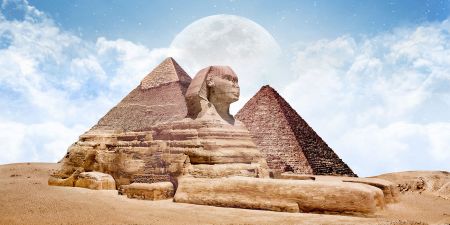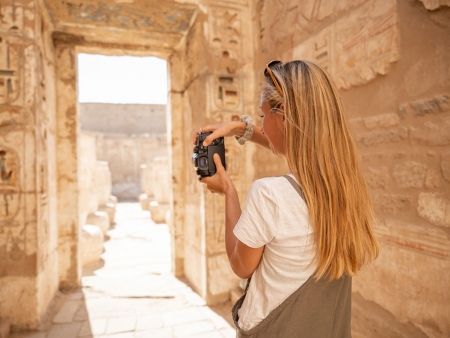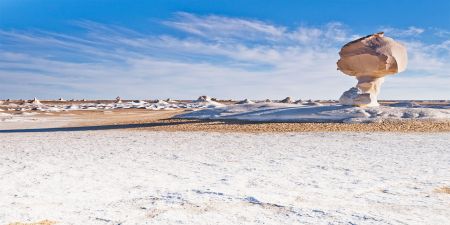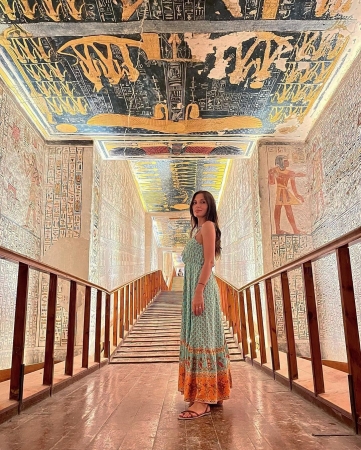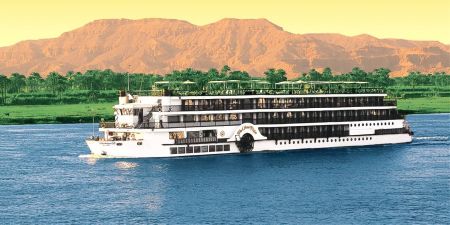ABU- Rawash, located in the continuation of Gebel el-Ghigiga. The western fringe of the Nile Valley (30°2'N,3l°4'E). The archaeological area of Abu Rowash, which belongs to the very northern part of the necropolis at Memphis, joins various sites together which date back to the Early Dynastic period, to the Coptic period.
This site is unfinished funerary complex of the forth dynasty ruler “Djedefra” (2566_2558 BC), the ancient name for which was "Djedefra" is a "sehedu star".
The king rained for about 8 years. This pyramid is very ruined condition today. The pyramid itself has a massive 49m channel cut into the bedrock to a 20m deep shaft. Djedefra’s cartouche was found in the burial chamber. That’s why we have said that this pyramid was built by him and was built out of lime stone.
The blocks of limestone, typical building blocks of the Giza tombs, were here angled towards the centre of the pyramid.The funerary complex of Djedefra, the third ruler of the fourth dynasty tc.2584—2576 BCE) was built at the top of this escarpment, on the plateau of Giza. The location of this pyramid has been known since the nineteenth century.
Between 1900 and 1902, Emile Chassinat discovered the remains of` a funerary settlement, a boat pit, and numerous statuary fragments that had the name of Didoufri (an early reading of (Djedefra), which allowed for the identification of the tombs owner ln 1912 and 1913. This site of the unfinished funerary complex of the forth dynasty ruler Djedefra (2566_2558 BC),the ancient name for which was "Djedefra" is a "sehedu star".
The mortuary temple on the east side of the pyramid and a large boat pit to the south were both excavated by Emile Chassinat in 1901. The boat pit contained many fragments of red quartzite statuary, including three painted heads from statues of Djedefra. One of which was probably from the earliest known royal sphinx.
Customize Your Dream Vacation!
Get in touch with our local experts for an unforgettable journey.
Plan Your TripEgypt Travel Guide
Egypt Oases
- Gara Cave
- Al-Deer
- Badr's Museum
- Bagawat
- Black desert
- Cleopatra bath
- Great Sand Sea
- Mizawaka
- Monastery of Anba Bishoy
- Mountain of the Dead in Siwa | Gebel al-Mawta
- Qarun Lake
- Roman Temple in Deir El-hagar
- Temple of Alexander the Great
- Temple of Amon
- Temple of Dush
- Temple of Hibis
- Temple of Nadura
- The Crystal Mountain | Bahariya Crystal Mountain
- The Monastery of Abu Makar (Makarios) | Egypt
- The Monastery of Baramus | Egypt
- The Monastery of El Suryan | Cairo Attractions
- Therapy in Siwa Oasis
- Valley of Al-Haiz
- Valley of the Golden Mummies
- Wadi Al- Rayan, Protected Area | Fayoum, Egypt
- Wadi El-Natroun | The Monasteries of Wadi El Natrun
- The White Desert in Egypt
- Fayoum Bird-watching Guide
Ports of Call
Red Sea and Sinai
Famous Mosques in Egypt
Transportation guide in Egypt
Egypt Tourist Attractions
Egypt Pyramids
- Djedefre Pyramid | Abu Rawash
- Abu Sir | Egyptian Necropolis & Pyramids
- King Snefru's Pyramid | Egypt
- Old Kingdom Pyramids | Ancient Egypt
- Pyramid Complex of Pepi I
- Pyramid of Amenemhat III
- Pyramid of lahun | Egypt Pyramids
- Pyramid of Meidum
- Pyramid of Neferhetepes | Egypt Pyramids
- Pyramid of Netjerkhet | Egypt Pyramids
- Pyramid of Neferefre
- Pyramid of Sahure | Egypt Pyramids
- Pyramid of Sekhemkhet
- Pyramid of Sesostris III
- Pyramid of Teti | Egypt Pyramids
- Pyramid of Userkaf | Egypt Pyramids
History of Egypt
- The False Doors | Ancient Egypt Secrets
- Egyptian Canopic Jars: What are Canopic Jars?
- Holy Family in Egypt
- king khufu (Cheops) | Kings of Ancient Egypt
- Khafre Statue | King Khafre Pyramid
- Who built the first pyramid in Egypt
- Menkaure (Mykerinos) Pyramid | King Menkaure
- Ramesses IV | Ramses iv Tomb
- Ramses IX Tomb
- The Divine Triad of Dendera
Aswan Attractions
Luxor Attractions
Alexandria Attractions
Cairo Attractions
- Famous Bab al Futuh
- Al-Tannoura Egyptian Heritage Dance Troupe
- Saints Sergius and Bacchus Church
- Abusir Pyramids & The City of The Dead Egypt
- Agricultural Museum Egypt, Cairo
- AL Fustat Historical City
- Bab El Nasr Cairo City Gate
- Beit Al Sennari or Al Sennari House in Cairo
- The Cairo Tower
- Birqash Camel Market in Cairo
- Coptic Cathedral in Abbasiya
- Egyptian Museum Guide
- El Mosky Cairo | Bazaars & Souks
- King Tutankhamun Treasures: Inside the World of Egypt’s Most Famous Pharaoh
- The Mosque of Muhammad Ali Pasha in Cairo
- Royal Mummy Room in The Egyptian Museum
- The Pharaonic Village
- The Great Sphinx of Giza
- Babylon Fortress Facts
- Solar Boat Museum
- Valley Temple of Khafre
- St Mary Egypt Orthodox Church
- Verdi Aida Opera Show in Giza Pyramids Egypt
Leaving your ship in Port Said, you will escape for the day to Cairo to the Great Pyramids of Giza and the Great Sphinx, as well as visit the famous Grand Egyptian Museum, full of antiquities from all over Egypt.
Combine the rich heritage of Cairo with a magical 5-day Nile cruise on this Egypt vacation package—a must for any lover of history. Follow the path of the pharaohs in Cairo, then fly continue the path in Luxor, and Aswan.
See two different sides of Egypt on this 6-day tour. In Cairo visit the Pyramids and the GEM. Travel to Bahariya Oasis to learn about Bedouin culture and camp in the desert. Enjoy the beautiful White Desert Safari in Egypt.
Start and end in Cairo. Enjoy the perfect combination of Egyptian culture and relaxation. This trip is ideal for those who want to have a taste of Egypt’s wonderful sites, as well as a good time to relax in Sharm El Sheikh.
This Travel Package to Egypt will take you to rural Egypt on the Nile and to the shores of the Red Sea. See the Pyramids and Sakkara. Cruise the Nile for 4 days and then relax in Sharm El Sheikh before returning to see Old Cairo and the Museum. In Sinai optional excursions into the desert and mountains are available.
Do it all in one trip. Start in Cairo, then travel by flight to Aswan and embark on your Nile Cruise and explore the majestic attractions of Egypt between Aswan and Luxor. End your tour with a relaxing time on Hurghada beaches.
Experience the beauty and history of the Nile in an unforgettable 8-day cruise package. You’ll visit the most ancient attractions in Cairo, Luxor, and Aswan, while making stops to enjoy other charming sites along the Nile.
Plan Your Trip!
You Might Also Like

ABU- Rawash, located in the continuation of Gebel el-Ghigiga. The western fringe of the Nile Valley (30°2'N,3l°4'E).

ABU-SIR, an archaeological locality on the western bank of the Nile River, approximately 25kilometers ( 15 miles) southwest of Cairo.

A site on the western bank of the Nile River; 65 kilometers south of Cairo. A step Mastaba and a royal cemetery were constructed there from the transitional years of the third to fourth dynasty.

Archaeologists have made many valuable discoveries in this area. We have the Saqqara complex, located 1.6 km inward from the escarpment where wooden bas-reliefs were found in the offering room of the mastaba of the high functionary Hesire.

Pepi I , the first king of the 6th Dynasty, had built his pyramid complex South Saqqara . His two immediate predecessors, Unas and Teti, Know More!
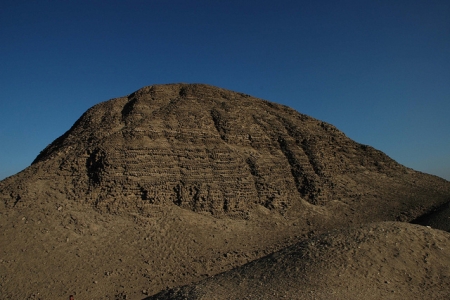
This pyramids owes its name to the fact that its core was made of white limestone. It has suffered a lot from stone robbers. Know more!

Lahun is the name of a modern village located near the opening of the Hawara Channel from the Nile Valley into the Fayum basin. Explore more about Lahun Pyramid with Memphis Tours!

It is located at medium, 80 km to the South of Memphis, on the Westbank of the Nile, to the East of Lake Moris and the Fayum oasis.

The pyramid is located about 100m south of Userkaf's pyramid, which is located at Sakkara. It was built for Neferhetepes who was a queen of Userkaf.
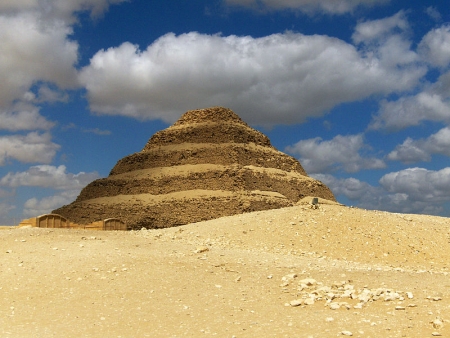
Standing 60 meters high, Netjerikhet's Step Pyramid, the oldest pyramid-like monument built in Egypt, was the centerpiece not only of the Netjerikhet complex but of the entire Saqqara area.
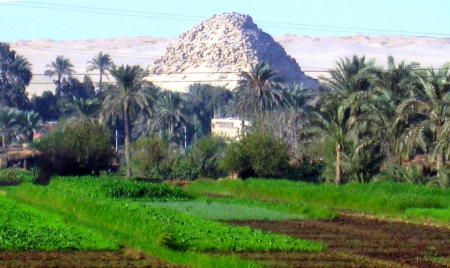
Recognize the story of Neferefre Pyramid through Memphis Tours! This pyramid is located at Abusir. It was built by King Raneferef, also known as Neferefre, who ruled for 3 or 4 years only during the 5th Dynasty.
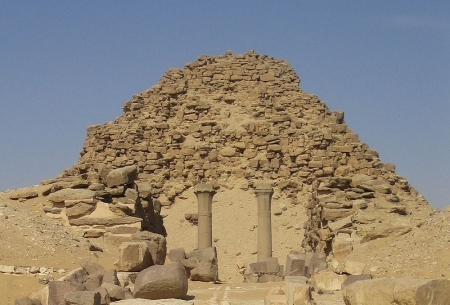
Sahure constructed the first pyramid at Abusir. A great many extremely beautiful high reliefs were found here by Borchardt when he excavated in 1902-1908.

Pyramid of Sekhemkhet is located just southwest of the pyramid of Unas, at Sakkara. It was built by Sekhemkhet, who was a pharaoh of the 3rd Dynasty and ruled for about 9 years. Explore Sekhemkhet now with Memphis Tours!

Located at Dahshur, Pyramid of Sesostris III is at some distance to the Northeast of Snofru's Red Pyramid. Know more!

Located in Central Saqqara just south of the 1st dynasty mastabas and northeast of Userkaf's pyramid, Pyramid of Teti was built by Teti, the first king of the 6th dynasty who ruled Egypt for some 32 years.

The local description for the the pyramid is el-haram el-makherbish "ruined pyramid". The pyramid is not on the tourist track and requires a 30 minute track through the soft sand from the step pyramid to reach.


